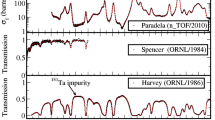Abstract
The production of 99Mo, 131I, and 133Xe radionuclides is very important for consumption in the field of nuclear medicine. Generally, the use of small core reactors is recommended for the production of large-scale these fission radionuclides. In this paper, we have considered three different core loading patterns of Tehran Research Reactor for the economic and optimum production of 99Mo, 131I and 133Xe from low-enriched uranium. These patterns are the large core, the small core with beryllium reflector (SC-Be), and the small core with graphite reflector. Simulation has been performed by MCNPX2.6 to compute the safety calculations, neutron flux changes, and evaluation of mentioned radionuclides production. The results reveal that the SC-Be is more suitable than the others two, in terms of safety. In this core, the drop of thermal neutron flux after loading the mini-plate targets is 11% and the activity of 99Mo, 131I, and 133Xe is 235, 227, and 592 Ci, respectively, at the 8 days after the end of irradiation. So, if the changing pattern of the small core is considered, the SC-Be should be suggested.








Similar content being viewed by others
References
S.M. Qaim, S. Sudár, B. Scholten et al., Evaluation of excitation functions of 100Mo (p, dþpn) 99Mo and 100Mo (p,2n) 99 mTc reactions: Estimation of long-lived Tc-impurity and its implication on the specific activity of cyclotron-produced 99 mTc. Appl. Radiat. Isot. 85, 101–113 (2014). https://doi.org/10.1016/j.apradiso.2013.10.004
A. Mushtaq, M. Iqbal, I.H. Bokhari et al., Neutronic and thermal hydraulic analysis for production of fission molybdenum-99 at Pakistan Research Reactor-1. Ann. Nucl. Energy 35(2), 345–352 (2008). https://doi.org/10.1016/j.anucene.2007.06.006
C. Dong-Keun, K. Myung-Hyun, L. Byung-Chul, Performance Uncertainties of LEU Mo-99 Targets for HANARO (2002)
A. Lokhov, The supply of medical isotopes: review of potential molybdenum 99/technetium-99m production technologies. Viena, Áustria:© OECD. Nuclear Development (2010)
E. Abedi, M. Ebrahimkhani, A. Davari et al., Neutronic and thermal-hydraulic analysis of fission molybdenum-99 production at Tehran Research Reactor using LEU plate targets. Appl. Radiat. Isot. 118, 160–166 (2016). https://doi.org/10.1016/j.apradiso.2016.09.011
N.M. Isotope’s(NWMI), Construction permit application for radioisotope production facility (2015)
E. Bradley, Non-HEU Production technologies for molybdenum-99 and technetium-99m (2013)
A. Lashkari, H. Khalafi, S.M. Mirvakili et al., Neutronic analysis for Tehran Research Reactor mixed-core. Prog. Nucl. Energy 60, 31–37 (2012). https://doi.org/10.1016/j.pnucene.2012.04.006
K. Farhadi, S. Khakshournia, feasibility study for Tehran research reactor power upgrading. Ann. Nucl. Energy 35(7), 1177–1184 (2008). https://doi.org/10.1016/j.anucene.2007.12.014
M. Gharib, Power upgrading of the Tehran research reactor. In: 10th International Topical Meeting Research Reactor Fuel Management. pp. 325–329 (2006). https://doi.org/10.1016/j.anucene.2007.12.014
AEOI (Atomic Energy Organization of Iran), Final Safety Analysis Report of Tehran Research Reactor (TRR) (2009)
B.P. Denise, MCNPX user’s manual version 2.6.0. LA-CP-07-1473. Los Alamos National Laboratory (2008)
J. Medel, G. Torres, Neutronic analysis for the fission Mo-99 production by irradiation of a LEU target at RECH-1 reactor (2007)
A.T. Silva, D.B. Domingos, T.G. Joao, et al., Neutronic and thermal-hydraulics calculations for the production of molybdenum-99 by fission in low enriched uranium UAlx-Al targets. RRFM. pp 19–23 (2015)
A. Mushtaq, M. Iqbal, I.H. Bokhari et al., Low enriched uranium foil plate target for the production of fission Molybdenum-99 in Pakistan Research Reactor-1. Nucl. Instrum. Methods Phys. Res., Sect. B 267(7), 1109–1114 (2009). https://doi.org/10.1016/j.nimb.2009.01.138
A. Mohammad, T. Mahmood, M. Iqbal, Fission MOLY production at PARR-1 using LEU plate type target. Nucl. Eng. Des. 239(3), 521–525 (2009). https://doi.org/10.1016/j.nucengdes.2008.11.008
J.Parma, Safety analysis for operating the Annular Core Research Reactor with Cintichem-type targets installed in the central region of the core. Sandia National Labs (2000)
R.M. Refeat, H.K. Louis, The effect of Mo production on the neutronic safety parameters of research reactors. Arab. J. Nucl. Sci. Appl. 47(1), 145–153 (2014)
D. Jo, K.-H. Lee, H.-C. Kim et al., Neutronic and thermal hydraulic analyses of LEU targets irradiated in a research reactor for Molybdenum-99 production. Ann. Nucl. Energy (2014). https://doi.org/10.1016/j.anucene.2014.04.017
Author information
Authors and Affiliations
Corresponding author
Rights and permissions
About this article
Cite this article
Safari, S.A., Tabasi, M., Ebrahimkhani, M. et al. Feasibility study on production of 99Mo, 131I, and 133Xe in the different core loading patterns of Tehran Research Reactor using MCNPX 2.6. Eur. Phys. J. Plus 135, 441 (2020). https://doi.org/10.1140/epjp/s13360-020-00474-w
Received:
Accepted:
Published:
DOI: https://doi.org/10.1140/epjp/s13360-020-00474-w




